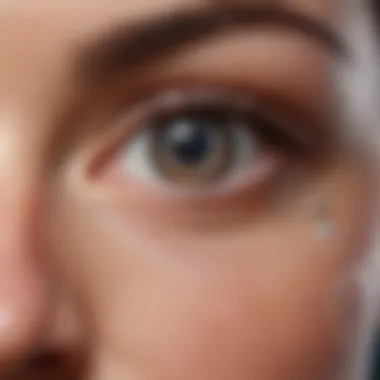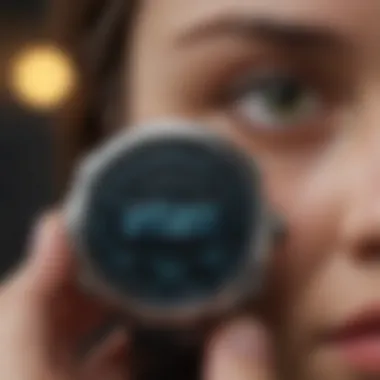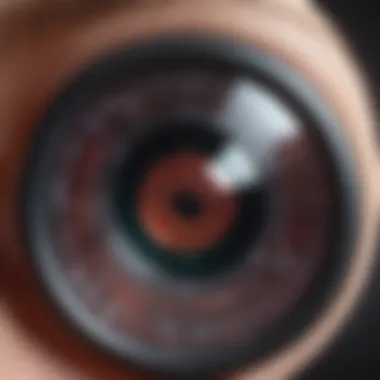Innovative Glucose-Sensing Contact Lenses for Diabetes


Intro
The innovation surrounding glucose-sensing contact lenses marks a significant shift in diabetes management. With diabetes affecting millions worldwide, researchers continually seek better ways to monitor glucose levels. Glucose-sensing contact lenses offer a non-invasive alternative to traditional methods like finger pricks. This technology could enhance patient adherence to glucose monitoring, ultimately improving health outcomes.
Article Overview
Summary of Key Findings
Glucose-sensing contact lenses utilize advanced biosensors to detect glucose levels in tear fluid. These lenses enable real-time monitoring, providing immediate feedback to users. Key findings suggest that this technology can lead to improved glycemic control and greater convenience for users. The lenses can also help to minimize the anxiety and discomfort associated with conventional glucose monitoring.
Research Objectives
The primary objective of this research is to explore the underlying technology of glucose-sensing contact lenses, their current clinical applications, and the potential risks and benefits of their use. Furthermore, this article aims to discuss the ethical considerations and challenges that lie ahead in integrating this technology into daily diabetes management.
Key Results and Discussions
Main Findings
Studies show that these contact lenses can accurately measure glucose levels, with results aligning closely to traditional blood glucose monitoring techniques. Research indicates potential for continuous glucose monitoring, which can provide alerts for hypo- or hyperglycemia. Implementation in real health scenarios is still in its infancy but shows promise based on initial trials.
Implications of Findings
The findings suggest that glucose-sensing contact lenses could revolutionize how diabetes is managed. Benefits include convenience, decreased stigma regarding monitoring, and the potential for better overall health management. Nonetheless, challenges remain. These include ensuring accuracy, managing user data privacy, and addressing the cost of such advanced technology. The balance between benefits and ethical considerations must be thoroughly examined.
"Technological advancements in glucose monitoring can enhance the quality of life for those with diabetes, but careful consideration of related ethical issues is crucial."
As research progresses, the implications of this technology extend beyond individual users to the healthcare system as a whole. With further studies and improved designs, glucose-sensing contact lenses may become a standard tool in diabetes management.
Intro to Glucose-Sensing Contact Lenses
The advent of glucose-sensing contact lenses represents a significant leap in diabetes management. These innovative devices are not merely a novelty; they potentially revolutionize how individuals monitor their glucose levels, shifting towards less invasive techniques. Understanding this topic is crucial given the growing prevalence of diabetes worldwide and the limitations of traditional monitoring practices. With conventional methods often requiring finger pricks or blood tests, the introduction of a non-invasive alternative paves the way for improved patient engagement and compliance.
The Evolution of Glucose Monitoring Techniques
Historically, glucose monitoring has undergone substantial transformation. Initially reliant on cumbersome blood sampling techniques, patients faced discomfort and inconvenience. Over the years, several methods emerged, such as continuous glucose monitors and flash glucose monitoring systems. Each iteration aimed to refine accuracy while minimizing discomfort.
Despite these advances, the need for a truly non-invasive solution has remained a priority. This gap in diabetes care led to research into alternative technologies, where glucose-sensing contact lenses first gained attention. The ability to measure glucose levels directly from tears introduces a new era in monitoring, fostering a less intrusive approach that aligns with modern patients' needs.
Understanding the Need for Non-Invasive Solutions
Non-invasive glucose monitoring solutions hold significant appeal for various reasons. First and foremost, they eliminate the pain and anxiety typically associated with drawing blood. Many patients, particularly children and those with needle phobia, face barriers to effective self-monitoring, leading to poor management of their condition.
Moreover, frequent blood sampling can discourage adherence to monitoring regimens. In contrast, glucose-sensing contact lenses offer a continuous monitoring solution that encourages regular data tracking, essential for effective diabetes management.
Additionally, the potential for real-time glucose level updates via a simple glance at a smartphone can bring the prospect of proactive management into reach. This aligns with current trends in healthcare where technology solutions integrate seamlessly into daily life, enhancing user experience and compliance.
"The development of glucose-sensing contact lenses could represent a pivotal moment in diabetes management, making monitoring feel less like a chore and more like a natural part of everyday life."
Technological Foundations
The technological foundations of glucose-sensing contact lenses are paramount to understanding their current capabilities and future potential. The relationship between robust sensor technology, materials science, and data analysis forms the basis for the innovation that is transforming diabetes management. Ensuring reliability and accuracy in measurements can significantly improve patient outcomes. The advancements in this field reflect a multi-disciplinary approach that bridges engineering, biology, and health informatics.
Sensor Design and Functionality


The design of sensors in glucose-sensing contact lenses is critical. These sensors must be sensitive enough to detect minute changes in glucose levels within the tear fluid. The use of electrochemical sensors is popular. They typically rely on enzymatic reactions involving glucose oxidase, which produces an electrical signal proportional to glucose concentration.
Characteristics such as responsiveness and stability must be optimized. The sensor should function effectively under various environmental conditions while maintaining comfort for the user. Additionally, the integration of miniaturized circuitry enables seamless communication with connected devices, providing real-time feedback to users and healthcare providers.
"Advancements in sensor technology open pathways for real-time monitoring and personalized diabetes management."
Materials Used in Manufacturing
Material selection is another essential aspect of glucose-sensing contact lenses. The lenses must be biocompatible, allowing prolonged contact with the eye without causing irritation. Hydrogel-based materials often serve this purpose well as they are soft and provide comfort. However, researchers are exploring advanced polymers that enhance the sensor's performance while maintaining eye safety.
Moreover, durable materials can improve the lifespan of the lenses, which is crucial for ensuring that patients do not need to frequently replace them. Effective coatings are also necessary to protect sensitive sensors from environmental contaminants and physical damage, which could interfere with glucose readings.
Data Collection and Interpretation
Data collection and interpretation processes are vital to translating sensor readings into actionable health information. The data gathered by glucose-sensing contact lenses must be accurate and reliable. This data is typically transmitted wirelessly to smartphones or dedicated devices, where algorithms analyze trends.
Machine learning and data analytics play significant roles in interpreting the information. By identifying patterns, users can receive alerts about potential hypoglycemia or hyperglycemia, enabling timely interventions. Continuous monitoring and comprehensive data interpretation can lead to improved diabetes management strategies, enhancing the patient’s quality of life.
The integration of these technologies creates a cohesive ecosystem aimed at better health outcomes for individuals living with diabetes.
Clinical Applications
The field of glucose-sensing contact lenses is an evolving area that holds great promise in the realm of diabetes care. Their development signifies a crucial advancement in the modality of glucose monitoring. Unlike traditional methods that usually require finger prick tests, these lenses provide a non-invasive solution for continuous glucose monitoring. This section elucidates the various clinical applications of glucose-sensing contact lenses, focusing on current research initiatives, their implementation in diabetes care, and how they compare to traditional monitoring methods.
Current Research Initiatives
Various research groups are currently engaged in projects aimed at refining glucose-sensing contact lenses. Institutions and companies alike are exploring ways to improve sensor accuracy and increase wearability. For instance, recent studies have investigated the integration of microneedle technology with contact lenses, potentially allowing for a better interaction with tear fluid, thus enhancing the precision of glucose measurements.
Key areas of research include:
- Development of biocompatible materials that can perform without causing irritation.
- Innovations in miniaturized sensors that can be embedded without affecting the lens's comfort and visual acuity.
- Exploration of advanced data algorithms that can translate sensor readings into actionable insights for users.
These initiatives are crucial for establishing the effectiveness of glucose-sensing contact lenses in clinical settings.
Implementation in Diabetes Care
Implementing glucose-sensing contact lenses into diabetes care can significantly change the management of the condition for many patients. These lenses could facilitate real-time glucose tracking. Patients would benefit from immediate feedback, which is crucial for timely interventions.
Some considerations for implementation include:
- Training healthcare professionals to use and interpret data gathered from these lenses effectively.
- Educational programs for patients to understand the benefits and limitations of using this new technology.
- Collaborations between manufacturers and health care providers to ensure proper integration into existing diabetes management regimens.
Thus, these lenses not only have the potential to empower patients but also to streamline workflows for diabetes care providers.
Comparative Effectiveness with Traditional Methods
Comparing glucose-sensing contact lenses with traditional glucose monitoring methods reveals several advantages as well as challenges. Finger prick methods, while effective, can be painful and inconvenient for users requiring frequent monitoring. In contrast, contact lenses provide a more user-friendly approach. They offer:
- Less discomfort due to their non-invasive nature.
- Continuous monitoring without the need for daily punctures, which can lead to higher compliance rates.
However, studies are needed to evaluate the reliability of the readings from glucose-sensing lenses versus those obtained through conventional methods. A thorough side-by-side examination is essential to understand how these lenses can complement or even replace existing glucose monitoring technologies.
"The transition from invasive to non-invasive solutions in diabetes management can fundamentally alter patient experiences and outcomes."
This comparison underlines the importance of continual research in the efficacy and long-term viability of glucose-sensing contact lenses in clinical applications.


Benefits of Glucose-Sensing Contact Lenses
The development of glucose-sensing contact lenses represents a significant advancement in diabetes management. These innovative lenses are not just a technological novelty; they carry substantial benefits for patients and healthcare systems alike. Understanding these benefits is crucial in evaluating the impact of such devices on diabetes care and the broader field of health monitoring.
Enhanced Patient Compliance
One of the most compelling advantages of glucose-sensing contact lenses is their potential to enhance patient compliance. Many individuals with diabetes face challenges with traditional monitoring techniques, which often require finger pricks or other intrusive methods. The discomfort and inconvenience associated with these procedures can lead to reluctance in regularly monitoring glucose levels.
In contrast, glucose-sensing contact lenses are designed for continuous wear, allowing for real-time glucose monitoring without the need for invasive measurements. This ease of use can significantly improve adherence to monitoring protocols, enabling patients to keep better track of their glucose levels. Consequently, improved compliance can lead to more effective diabetes management, reducing the risk of complications associated with poorly controlled blood sugar.
Reduction in Invasive Procedures
Another prominent benefit of glucose-sensing contact lenses is the reduction in invasive procedures. Traditional glucose monitoring typically involves puncturing the skin to obtain blood samples, a method that not only causes discomfort but also presents risks of infection or incorrect measurement due to user error.
With glucose-sensing lenses, users can avoid these invasive procedures altogether. This non-invasive method could encourage more patients to engage actively in their health management. Furthermore, less reliance on invasive monitoring can decrease healthcare costs associated with diabetes treatment. The potential for reduced hospital visits due to better-managed blood sugar levels presents a significant economic advantage for healthcare systems.
Continuous Monitoring and Instant Alerts
The capability for continuous monitoring is another noteworthy benefit of glucose-sensing contact lenses. These lenses are designed to measure glucose levels in real time, offering a level of monitoring that is not possible with traditional methods. Continuous data collection allows patients to observe their glucose trends throughout the day, providing insights into how dietary choices, activities, and medications affect their numbers.
In addition, the integration of alert systems can notify users of abnormal glucose levels immediately. Such instant alerts could be life-saving, preventing potential hypoglycemic or hyperglycemic episodes. The ability to receive timely information empowers patients to make informed decisions regarding their health, possibly leading to improved outcomes.
"Continuous glucose monitoring with non-invasive methods can change how we view diabetes management."
In summary, the benefits of glucose-sensing contact lenses are multifaceted. Enhanced patient compliance, a reduction in invasive procedures, and continuous monitoring with instant alerts highlight the significant advantages these technological advancements offer to individuals living with diabetes. As research continues and these technologies evolve, their potential to improve diabetes care and patient quality of life becomes increasingly evident.
Limitations and Challenges
Understanding the limitations and challenges associated with glucose-sensing contact lenses is crucial for evaluating their feasibility and long-term adoption in diabetes management. These constraints can significantly influence research, market introduction, and patient acceptance. The development of these lenses represents an intersection of innovative technology and healthcare, making it imperative to address both their technical barriers and societal implications.
Technical and Design Challenges
The design of glucose-sensing contact lenses poses several technical challenges. One of the primary issues lies in ensuring the accuracy and reliability of glucose readings. Glucose sensors must effectively detect subtle changes in glucose levels, which requires sophisticated biosensing materials and technologies. The integration of these sensors into a flexible lens form factor without compromising comfort and wearability remains a notable hurdle.
Moreover, maintaining sensor functionality over time is also a concern. Since these lenses must be regularly worn for accurate monitoring, durability against environmental factors such as moisture and temperature fluctuations is essential. Innovations in microsensors and biocompatible materials are vital to overcoming these design challenges. Researchers are actively exploring novel materials that can enhance the lens' performance and lifespan, but progress is ongoing and requires thorough testing.
Regulatory Hurdles
Regulatory pathways present another layer of challenges before glucose-sensing contact lenses can be widely adopted. In the United States, for instance, these devices are categorized as medical devices and must undergo rigorous evaluation processes by the FDA. Demonstrating safety and efficacy often requires extensive clinical trials, which can be time-consuming and resource-intensive. Compliance with these regulatory requirements not only affects the timeline for bringing products to market but also impacts the overall development costs.
International regulations can vary significantly, complicating the global adoption of these lenses. Manufacturers must navigate a patchwork of regulatory environments, which can delay market entry and require adaptations to designs and testing approaches. This regulatory complexity can deter investment and innovation in this promising field.
User Acceptance and Market Viability
User acceptance is critical for the success of glucose-sensing contact lenses. Patients may be hesitant to adopt a new technology, particularly one so closely related to their health management. Issues of comfort, ease of use, and the perceived accuracy of these lenses will heavily influence acceptance. For instance, if users are accustomed to traditional methods of glucose monitoring, shifting to a novel approach will require significant educational initiatives to convey the benefits and operational simplicity of glucose-sensing lenses.
Additionally, the price point of these advanced lenses could affect market penetration. If costs are excessively high compared to existing monitoring methods, patients may be less inclined to switch. Achieving a balance between advanced technology and affordability will play a pivotal role in determining market viability.
"The integration of technology and personal health solutions has a direct impact on adoption rates. User trust and comfort cannot be taken for granted."
Ethical and Social Considerations
The introduction of glucose-sensing contact lenses, while a significant leap in technology, brings forth a host of ethical and social considerations that merit thorough examination. These lenses aim to revolutionize diabetes management, yet their deployment poses questions about privacy, data security, and equity, making it essential to address these concerns as part of their acceptance and use in society.


Privacy Concerns
As glucose-sensing contact lenses gather sensitive health data, privacy becomes a pivotal issue. Users must be informed about how their data is collected, used, and shared. Consent is not just a formality; it is crucial for building trust. With digital health solutions, the potential for unauthorized access to personal information increases. Therefore, developers of these lenses must implement robust privacy policies to protect users from misuse of their health data. Furthermore, education on privacy rights is essential, enabling users to make informed decisions about their health information.
Data Security Issues
Another significant aspect is data security, particularly in the digital age. The efficiency of glucose-sensing contact lenses relies heavily on constant data collection and transmission. However, if this data is intercepted or hacked, it poses a severe risk to individuals’ health and well-being. It is important for manufacturers to incorporate advanced encryption technologies and secure platforms for data transmission. Regular audits and updates should also be conducted to ensure security measures remain robust against emerging threats. Ultimately, a secure environment will foster user confidence in using these innovative devices.
Equity in Healthcare Access
Finally, equity in healthcare access is a pressing concern in the deployment of glucose-sensing contact lenses. As with many technological advancements, there is a risk that access may be limited to certain income groups or geographic locations. This could exacerbate existing disparities in diabetes care. Health systems and policymakers need to advocate for equitable access to these technologies, ensuring that all populations, regardless of socioeconomic status, can benefit from advancements in monitoring and managing diabetes. Strategies might include subsidization or inclusion in public health programs to promote widespread adoption and access.
"Addressing ethical considerations in technology helps ensure that all individuals can benefit from innovations such as glucose-sensing contact lenses."
In summary, while glucose-sensing contact lenses offer promising advancements in health technology, the ethical and social implications must not be overlooked. By focusing on privacy, data security, and equitable access, stakeholders can work towards a future where these innovations are available to everyone.
Future Prospects
The future of glucose-sensing contact lenses holds significant potential for transforming diabetes care and monitoring. As technology evolves, these innovative devices can pave the way for more precise and convenient glucose monitoring, profoundly impacting the quality of life for millions of people with diabetes. The importance of this topic lies in its capability to improve clinical outcomes, enhance patient adherence to monitoring protocols, and reduce complications related to diabetes management.
Innovative Research Directions
The ongoing research in this field is varied and dynamic. Scientists are exploring different approaches to improve the functionality of glucose-sensing contact lenses, focusing on accuracy and usability. One area of investigation is the development of more sensitive biosensors that can detect glucose levels with greater precision. This can be achieved by integrating nanomaterials or advanced polymer matrices into the sensor design.
Furthermore, researchers are considering the incorporation of artificial intelligence algorithms that can learn and adapt to individual user patterns. This could provide personalized feedback and alerts, enhancing the practical use of these lenses in real time. Many papers and studies outlined in publications such as Britannica highlight the importance of decreasing errors in glucose readings, which is a common limitation in current systems.
Integration with Other Health Monitoring Systems
The integration of glucose-sensing contact lenses with other health monitoring systems is another critical area for future development. The potential for these lenses to sync with wearables, such as smartwatches or fitness trackers, enables a holistic approach to health monitoring. Data from multiple sources can provide a comprehensive view of a person’s health, including activity level, heart rate, and sleep patterns.
By consolidating this information, users can receive tailored insights about their health and well-being. For example, if the glucose readings indicate a spike, the user could also receive a notification to adjust their activity or food intake. This interconnected system can enhance the management of diabetes, allowing for proactive instead of reactive care.
Long-Term Clinical Outcomes and Studies
Long-term clinical studies are essential to fully understand the impacts and efficacy of glucose-sensing contact lenses in real-world situations. While preliminary studies show promise, thorough and extended evaluations will yield insights into their effectiveness over time. These studies will provide data on long-term wear comfort, user experience, and specific health outcomes related to diabetes management.
Examining various patient populations, inclusive of diverse demographics, will also help in recognizing barriers to acceptance or efficacy. The data collected can guide future product improvements and regulatory considerations. In summary, investing in long-term studies is crucial for validating the technology’s clinical relevance and ensuring it meets the needs of users.
"Innovative advancements in glucose-sensing technology must prioritize user comfort and data accuracy to become a trusted part of diabetes care."
The future holds promise, but ensuring these devices are practical and effective will require commitment from researchers and the industry.
Closure
The conclusion serves as a pivotal section in this article. It encapsulates the significant advancements and implications of glucose-sensing contact lenses, reiterating their importance in the realm of diabetes management. This novel technology represents a potential shift in how patients monitor their glucose levels. The benefits of real-time, non-invasive glucose monitoring cannot be overstated. Patients may experience reduced discomfort and increased compliance compared to traditional methods.
Summation of Key Points
In this article, several key points were examined:
- Technological Development: The evolution of technologies that enable glucose-sensing in contact lenses marks a significant leap in non-invasive monitoring methods.
- Clinical Applications: Current research initiatives are focusing on improving the efficacy of these lenses for diabetes care. The potential to provide immediate feedback to patients can enhance their ability to manage their condition effectively.
- Benefits and Limitations: While offering many advantages, including enhanced patient compliance, glucose-sensing contact lenses also face limitations such as technical challenges and regulatory hurdles.
- Ethical Considerations: Privacy concerns and data security issues related to continuous monitoring need careful consideration to ensure equitable access.
- Future Prospects: Ongoing research and innovation in this area promise not only improvements in technology but also integration with broader health monitoring systems.
Call for Continued Research and Funding
To fully realize the potential of glucose-sensing contact lenses, a concerted effort for further research and funding is essential. This development is not just about technology; it encompasses understanding human factors, expanding healthcare access, and ensuring patient education.
Investments in research can lead to breakthroughs that address existing technological and regulatory barriers. Furthermore, funding can facilitate large-scale clinical trials that solidify the credibility of these devices in everyday scenarios. The impact this technology can have on diabetes care might change lives, improve health outcomes, and reduce the burden of chronic disease management.
"Continued research and proper funding are critical for advancing glucose-sensing technology, ensuring it reaches its full potential in transforming diabetes management."
In summary, the path ahead requires collaboration between researchers, healthcare providers, and policymakers to innovate solid structures for effective implementation that resonates with current and future healthcare systems.







